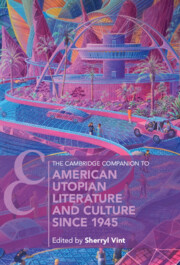43 results
Contributors
-
- Book:
- The Cambridge Companion to American Utopian Literature and Culture since 1945
- Published online:
- 09 May 2024
- Print publication:
- 16 May 2024, pp viii-xii
-
- Chapter
- Export citation
Introduction
-
-
- Book:
- The Cambridge Companion to American Utopian Literature and Culture since 1945
- Published online:
- 09 May 2024
- Print publication:
- 16 May 2024, pp 1-22
-
- Chapter
- Export citation
Figures
-
- Book:
- The Cambridge Companion to American Utopian Literature and Culture since 1945
- Published online:
- 09 May 2024
- Print publication:
- 16 May 2024, pp vii-vii
-
- Chapter
- Export citation
Works Cited
-
- Book:
- The Cambridge Companion to American Utopian Literature and Culture since 1945
- Published online:
- 09 May 2024
- Print publication:
- 16 May 2024, pp 287-309
-
- Chapter
- Export citation
Contents
-
- Book:
- The Cambridge Companion to American Utopian Literature and Culture since 1945
- Published online:
- 09 May 2024
- Print publication:
- 16 May 2024, pp v-vi
-
- Chapter
- Export citation
Copyright page
-
- Book:
- The Cambridge Companion to American Utopian Literature and Culture since 1945
- Published online:
- 09 May 2024
- Print publication:
- 16 May 2024, pp iv-iv
-
- Chapter
- Export citation
Index
-
- Book:
- The Cambridge Companion to American Utopian Literature and Culture since 1945
- Published online:
- 09 May 2024
- Print publication:
- 16 May 2024, pp 310-312
-
- Chapter
- Export citation

The Cambridge Companion to American Utopian Literature and Culture since 1945
-
- Published online:
- 09 May 2024
- Print publication:
- 16 May 2024
The Metaeconomics of Hernan Diaz's Trust
-
- Journal:
- PMLA / Publications of the Modern Language Association of America / Volume 138 / Issue 5 / October 2023
- Published online by Cambridge University Press:
- 02 January 2024, pp. 1206-1211
- Print publication:
- October 2023
-
- Article
- Export citation
Chapter 7 - Life Optimized
-
- Book:
- Biopolitical Futures in Twenty-First-Century Speculative Fiction
- Published online:
- 16 September 2021
- Print publication:
- 07 October 2021, pp 157-181
-
- Chapter
- Export citation
Acknowledgments
-
- Book:
- Biopolitical Futures in Twenty-First-Century Speculative Fiction
- Published online:
- 16 September 2021
- Print publication:
- 07 October 2021, pp viii-x
-
- Chapter
- Export citation
Chapter 6 - Living to Work
-
- Book:
- Biopolitical Futures in Twenty-First-Century Speculative Fiction
- Published online:
- 16 September 2021
- Print publication:
- 07 October 2021, pp 134-156
-
- Chapter
- Export citation
Copyright page
-
- Book:
- Biopolitical Futures in Twenty-First-Century Speculative Fiction
- Published online:
- 16 September 2021
- Print publication:
- 07 October 2021, pp vi-vi
-
- Chapter
- Export citation
Notes
-
- Book:
- Biopolitical Futures in Twenty-First-Century Speculative Fiction
- Published online:
- 16 September 2021
- Print publication:
- 07 October 2021, pp 210-253
-
- Chapter
- Export citation
Chapter 4 - Surplus Value
-
- Book:
- Biopolitical Futures in Twenty-First-Century Speculative Fiction
- Published online:
- 16 September 2021
- Print publication:
- 07 October 2021, pp 90-109
-
- Chapter
- Export citation
Index
-
- Book:
- Biopolitical Futures in Twenty-First-Century Speculative Fiction
- Published online:
- 16 September 2021
- Print publication:
- 07 October 2021, pp 265-272
-
- Chapter
- Export citation
Bibliography
-
- Book:
- Biopolitical Futures in Twenty-First-Century Speculative Fiction
- Published online:
- 16 September 2021
- Print publication:
- 07 October 2021, pp 254-264
-
- Chapter
- Export citation
Conclusion
-
- Book:
- Biopolitical Futures in Twenty-First-Century Speculative Fiction
- Published online:
- 16 September 2021
- Print publication:
- 07 October 2021, pp 199-209
-
- Chapter
- Export citation
Chapter 8 - Surplus Vitality and Posthuman Possibilities
-
- Book:
- Biopolitical Futures in Twenty-First-Century Speculative Fiction
- Published online:
- 16 September 2021
- Print publication:
- 07 October 2021, pp 182-198
-
- Chapter
- Export citation
Chapter 5 - Life Industries
-
- Book:
- Biopolitical Futures in Twenty-First-Century Speculative Fiction
- Published online:
- 16 September 2021
- Print publication:
- 07 October 2021, pp 110-133
-
- Chapter
- Export citation



